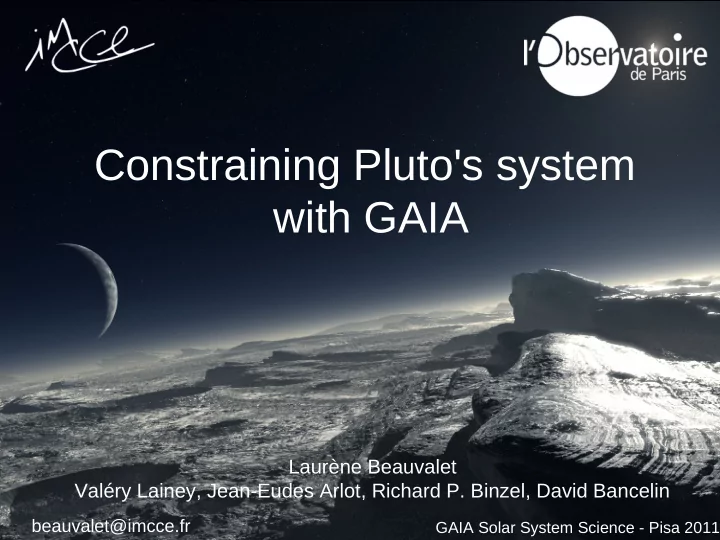

Constraining Pluto's system with GAIA Laurène Beauvalet Valéry Lainey, Jean-Eudes Arlot, Richard P. Binzel, David Bancelin beauvalet@imcce.fr GAIA Solar System Science - Pisa 2011
Plan Introduction Dynamical Model Data simulation Results Conclusion
Introduction Pluto's system : Distance from the Sun : ~ 33 AU in 2013 4 objects : Pluto (R=1170 km, V=15.1, D~100 mas ) Charon (R=603 km, V=16.8, D~55 mas ) Nix (R=44 km, V=23.7, D~4 mas ) Hydra (R=36 km, V=23.3, D~3 mas ) Mission New Horizons, arrival in Pluto's system in 2015
Dynamical model Binary object → center of mass not within the primary Coupling between heliocentric motion of the primary and orbital motion of the satellites
Dynamical model Binary object → center of mass not within the primary Coupling between heliocentric motion of the primary and orbital motion of the satellites → solution : fitting the motion of every object around the Sun
Numerical integration of four objects' motion around the Sun Planetary and Sun perturbations using DE406 Initial conditions and masses from DE406 and Tholen (2008) No spherical harmonics included
Data simulation Goal : estimate the uncertainty we will obtain with a set of observations Method : Simulation of observations according to the tested schedule Fitting of the model to the simulations, fitted parameters : initial positions and velocities, and masses Extraction of the 1-σ uncertainty from the least-square procedure
Schedules used : Currently available observations of the satellites (Buie 2006, Weaver et al. 2005, Sicardy et al. 2006, Tholen 1997) Simulation of future observations between 2010 and 2014, 10 per year New Horizons schedule and uncertainty GAIA schedule simulation New Horizons : short period observations, varying precision with the distance of the probe, observations of the four objects of the system GAIA : observations simulated from 2013 to 2017, 1 mas constant precision, only Pluto and Charon observed
Pluto's right ascension during the observations of GAIA and New Horizons
Results 1-σ error bars on the masses given by least square method using different sets of simulated observations, with m1 = 870.3 km 3 .s −2 , m2 = 101.4 km 3 .s −2 , m3 = 0.039 km 3 .s −2 and m4 = 0.021 km 3 .s −2 .
Orbit enhancement thanks to GAIA before New Horizons arrival
Conclusion GAIA will be able to improve the orbit of Pluto's satellites, even before New Horizons arrival GAIA will improve the uncertainties on the system's masses Though GAIA does not observe Nix and Hydra, the constraints put on Pluto and Charon are expected to lower the uncertainties on Nix's and Hydra's dynamical parameters
Why constraining Pluto and Charon helps ? What influences Nix's and Hydra's orbit : Masses Positions of Pluto and Charon When adjusting the orbit, the residuals are reduced by adjusting parameters If a parameter which has a strong influence on Pluto and Charon motion is fixed, it can no longer absorb the residuals → constraining Pluto's and Charon's dynamical parameters means higher residuals on Nix and Hydra → clearer effect of their dynamical parameters → higher precision on these parameters
years Post-fit residuals of a model with a massless Nix fitted to simulated observations with GM Nix =0.039 ± 0.034 km 3 .s -2
Post-fit residuals of a model with a massless Nix fitted to simulated observations with GM Nix =0.039 ± 0.034 km 3 .s -2
Recommend
More recommend